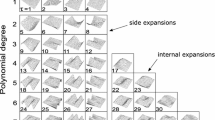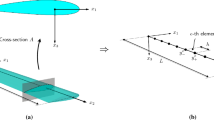Abstract
This paper proposes a refined beam formulation with displacement variables only. Lagrange-type polynomials, in fact, are used to interpolate the displacement field over the beam cross-section. Three- (L3), four- (L4), and nine-point (L9) polynomials are considered which lead to linear, quasi-linear (bilinear), and quadratic displacement field approximations over the beam cross-section. Finite elements are obtained by employing the principle of virtual displacements in conjunction with the Unified Formulation (UF). With UF application the finite element matrices and vectors are expressed in terms of fundamental nuclei whose forms do not depend on the assumptions made (L3, L4, or L9). Additional refined beam models are implemented by introducing further discretizations over the beam cross-section in terms of the implemented L3, L4, and L9 elements. A number of numerical problems have been solved and compared with results given by classical beam theories (Euler-Bernoulli and Timoshenko), refined beam theories based on the use of Taylor-type expansions in the neighborhood of the beam axis, and solid element models from commercial codes. Poisson locking correction is analyzed. Applications to compact, thin-walled open/closed sections are discussed. The investigation conducted shows that: (1) the proposed formulation is very suitable to increase accuracy when localized effects have to be detected; (2) it leads to shell-like results in case of thin-walled closed cross-section analysis as well as in open cross-section analysis; (3) it allows us to modify the boundary conditions over the cross-section easily by introducing localized constraints; (4) it allows us to introduce geometrical boundary conditions along the beam axis which lead to plate/shell-like cases.
Similar content being viewed by others
References
Bathe K (1996) Finite element procedure. Prentice Hall, New York
Carrera E (2002) Theories and finite elements for multilayered, anisotropic, composite plates and shells. Arch Comput Methods Eng 9(2):87–140
Carrera E (2003) Theories and finite elements for multilayered plates and shells: a unified compact formulation with numerical assessment and benchmarking. Arch Comput Methods Eng 10(3):216–296
Carrera E, Brischetto S (2008) Analysis of thickness locking in classical, refined and mixed multilayered plate theories. Compos Struct 82(4):549–562
Carrera E, Brischetto S (2008) Analysis of thickness locking in classical, refined and mixed theories for layered shells. Compos Struct 85(1):83–90
Carrera E, Giunta G (2010) Refined beam theories based on Carrera’s unified formulation. Int J Appl Mech 2(1):117–143
Carrera E, Petrolo M (2011) On the effectiveness of higher-order terms in refined beam theories. J Appl Mech 78(2). doi:10.1115/1.4002207
Carrera E, Giunta G, Nali P, Petrolo M (2010) Refined beam elements with arbitrary cross-section geometries. Comput Struct 88(5–6):283–293. doi:10.1016/j.compstruc.2009.11.002
Carrera E, Petrolo M, Nali P (2011) Unified formulation applied to free vibrations finite element analysis of beams with arbitrary section. Shock Vib 18(3):485–502. doi:10.3233/SAV-2010-0528
Carrera E, Petrolo M, Varello A (2011) Advanced beam formulations for free vibration analysis of conventional and joined wings. J Aerosp Eng. doi:10.1061/(ASCE)AS.1943-5525.0000130
Carrera E, Petrolo M, Zappino E (2011) Performance of CUF approach to analyze the structural behavior of slender bodies. J Struct Eng. doi:10.1061/(ASCE)ST.1943-541X.0000402
Dinis P, Camotim D, Silvestre N (2006) GBT formulation to analyse the buckling behaviour of thin-walled members with arbitrarily ‘branched’ open cross-sections. Thin-Walled Struct 44:20–38
Eisenberger M (2003) An exact high order beam element. Comput Struct 81:147–152
El Fatmi R (2007) Non-uniform warping including the effects of torsion and shear forces. Part I: a general beam theory. Int J Solids Struct 44:5912–5929
El Fatmi R (2007) Non-uniform warping including the effects of torsion and shear forces. Part II: analytical and numerical applications. Int J Solids Struct 44:5930–5952
Euler L (1744) De curvis elasticis. Bousquet, Lausanne
Gruttmann F, Wagner W (2001) Shear correction factors in Timoshenko’s beam theory for arbitrary shaped cross-sections. Comput Mech 27:199–207
Gruttmann F, Sauer R, Wagner W (1999) Shear stresses in prismatic beams with arbitrary cross—sections. Int J Numer Methods Eng 45:865–889
Jönsson J (1999) Distortional theory of thin-walled beams. Thin-Walled Struct 33:269–303
Kapania K, Raciti S (1989) Recent advances in analysis of laminated beams and plates, part I: shear effects and buckling. AIAA J 27(7):923–935
Kapania K, Raciti S (1989) Recent advances in analysis of laminated beams and plates, part II: vibrations and wave propagation. AIAA J 27(7):935–946
Novozhilov VV (1961) Theory of elasticity. Pergamon, Elmsford
Oñate E (2009) Structural analysis with the finite element method: linear statics, vol 1. Springer, Berlin
Petrolito J (1995) Stiffness analysis of beams using a higher-order theory. Comput Struct 55(1):33–39
Reddy JN (1997) On locking-free shear deformable beam finite elements. Comput Methods Appl Mech Eng 149:113–132
Reddy JN (2004) Mechanics of laminated composite plates and shells. Theory and analysis, 2nd edn. CRC Press, Boca Raton
Rendek S, Baláž I (2004) Distortion of thin-walled beams. Thin-Walled Struct 42:255–277
Saadé K, Espion B, Warzée G (2004) Non-uniform torsional behavior and stability of thin-walled elastic beams with arbitrary cross sections. Thin-Walled Struct 42:857–881
Silvestre N (2007) Generalised beam theory to analyse the buckling behaviour of circular cylindrical shells and tubes. Thin-Walled Struct 45:185–198
Timoshenko SP (1921) On the corrections for shear of the differential equation for transverse vibrations of prismatic bars. Philos Mag 41:744–746
Timoshenko SP (1922) On the transverse vibrations of bars of uniform cross section. Philos Mag 43:125–131
Tsai SW (1988) Composites design, 4th edn. Think Composites, Dayton
Vinayak RU, Prathap G, Naganarayana BP (1996) Beam elements based on a higher order theory—I. Formulation and analysis of performance. Comput Struct 58(4):775–789
Wagner W, Gruttmann F (2002) A displacement method for the analysis of flexural shear stresses in thin—walled isotropic composite beams. Comput Struct 80:1843–1851
Yu W, Hodges DH (2004) Elasticity solutions versus asymptotic sectional analysis of homogeneous, isotropic, prismatic beams. J Appl Mech 71:15–23
Yu W, Volovoi VV, Hodges DH, Hong X (2002) Validation of the variational asymptotic beam sectional analysis (VABS). AIAA J 40:2105–2113
Author information
Authors and Affiliations
Corresponding author
Additional information
An erratum to this article can be found at http://dx.doi.org/10.1007/s11012-012-9539-0.
Rights and permissions
About this article
Cite this article
Carrera, E., Petrolo, M. Refined beam elements with only displacement variables and plate/shell capabilities. Meccanica 47, 537–556 (2012). https://doi.org/10.1007/s11012-011-9466-5
Received:
Accepted:
Published:
Issue Date:
DOI: https://doi.org/10.1007/s11012-011-9466-5




